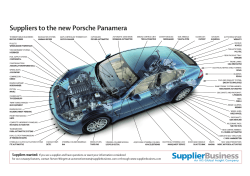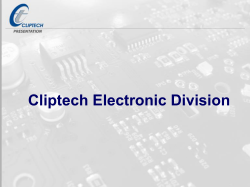
Tech Videos
Migrating Consumer Electronics to the Automotive World with Calibre PERC Matthew Hogan, Mentor Graphics Migrating Consumer Electronics to the Automotive World with Calibre PERC Automotive consumers are demanding more than just transportation from their vehicles, in the form of connected cars [1] and increasingly elaborate infotainment systems, all of which must be developed and supported by integrated circuit (IC) manufacturers [2]. These demands present a great opportunity for new entrants into this market, but only if they can meet the reliability challenges necessary for automotive electronics applications. When it comes to safety-related automotive electronics, ISO 26262 [3] provides a framework for robust and reliable design and verification practices. Compliance is an obligation for competitive products in this market. But what of the reliability obligations for non-safety related systems? In-vehicle infotainment (IVI) and connected car systems need high-reliability IC designs for marketability and brand perception, but out-of-specification performance for these ICs results primarily in customer dissatisfaction. While failure may lead to a significant negative market reaction, it does not create the concern and accountability incurred if a safety-critical IC fails [4]. New entrants into the automotive IC ecosystem must prove themselves as consistent suppliers of reliable parts. Competing against incumbents in the automotive industry that have a successful track record for years can be a long and uphill battle [5]. This attractive, high growth market does have standards, like those established by the Automotive Electronics Council (AEC) [6], but understanding how to appropriately apply and comply with these standards in a competitive marketplace may be challenging to those without experience. The harsh environment present in automotive electronics operation [7] combined with the high reliability requirements for verification of these ICs [8] provides design and verification challenges that are not commonly encountered when designing and developing ICs intended for less-demanding settings. While questions like which electrostatic discharge (ESD) or electrical overstress (EOS) compliance standards need to be met (and at what level) are often answered in industry standards documents [6], what’s less obvious are the challenges, design trade-offs, and best practices used to achieve compliance with these standards. CHALLENGES WITH EXISTING IP REUSE Leveraging existing IP for use in high-reliability applications poses a number of challenges. One of the most obvious is that of correct functional operation over the wide temperature ranges encountered in automotive applications. Altera defines five temperature grades for its products [9]: ■■ Commercial: 0°C to 85°C ■■ Industrial: −40°C to 100°C ■■ Automotive: −40°C to 125°C ■■ E xtended: −40°C to 125°C ■■ Military: −55°C to 125°C The AEC-Q100-Rev-G Base Document [6] specifies part operating grades at the following levels: ■■ Grade 0: -40°C to +150°C ambient operating temperature range ■■ Grade 1: -40°C to +125°C ambient operating temperature range ■■ Grade 2: -40°C to +105°C ambient operating temperature range ■■ Grade 3: -40°C to +85°C ambient operating temperature range ■■ Grade 4: 0°C to +70°C ambient operating temperature range When re-targeting an IC design for automotive applications, understanding which grade you want to achieve can impact the product’s viability in the marketplace and, ultimately, its reliability. How much re-design is required to attain reliable operation at one grade vs. another? How will your grade choice impact overall sales and performance of the design? w w w. m e nto r. co m 2 [ 5] Migrating Consumer Electronics to the Automotive World with Calibre PERC The AEC electrical component qualification requirements laid out in the Q100 documents [6] provide testing and compliance requirements for a statistically significant number of parts in several functional areas: ■■ ESD protection: All products ■■ Latch-up (LU) prevention: All products ■■ E lectrical Distribution: The supplier must demonstrate, over the operating temperature grade, voltage, and frequency ranges, that the device is capable of meeting the parametric limits of the device specification. This data must be taken from at least three lots, or one matrixed (skewed) process lot, and must represent enough samples to be statistically valid, see Q100-009. It is strongly recommended that the final test limits be established using AEC-Q001 Guidelines for Part Average Testing. ■■ O ther Tests: A user may require other tests in lieu of generic data based on experience with a particular supplier. As with all standards, it is important to evaluate the relevance and applicability to your design and technology. Are the ESD tests they call for appropriate for your application? If you are designing with an SOI technology, are the latch-up rules (necessary for bulk technologies) relevant or appropriate to your design? The AEC electrical component qualification requirements also identify wearout reliability tests, which specify the testing of several failure mechanisms. ■■ Electromigration ■■ T ime-Dependent Dielectric Breakdown (or Gate Oxide Integrity Test)—for all MOS technologies ■■ Hot Carrier Injection—for all MOS technologies below 1 micron ■■ Negative Bias Temperature Instability ■■ Stress Migration Verification against these failure modes during the design process provides assurance for the actual device performance. AUTOMATING RELIABILITY VERIFICATION Finding a verification environment capable of these diverse failure modes can be a daunting task. Fortunately, a new class of IC reliability verification tool, such as Calibre® PERC™, can consider these problem domains in a single cohesive environment. Created out of the need to improve the coverage of IC reliability verification in a circuitaware context, Calibre PERC allows designers to perform a focused analysis of circuit implementation from both a circuit topology and layout perspective. As part of this analysis, external constraints can be leveraged to direct the intent of checks and help determine which circuits are out of compliance. A reliability verification tool that can understand and assess those constraints is essential to identifying reliability issues and ensuring compliance with reliability requirements and industry standards. One common example is protection and verification against time-dependent dielectric breakdown (TDDB) in interconnects (often called voltage-aware DRC [10]), where reliability verification in electrical overstress (EOS) environments plays a critical role. Figure 1 shows a voltage-aware DRC reliability verification flow using the Calibre® PERC™ tool. The flow occurs entirely within the Calibre PERC environment. Both TDDB and EOS require larger design areas to avoid failure, but both are critical to mitigate in high- reliability IC designs. w w w. m e nto r. co m 3 [ 5] Migrating Consumer Electronics to the Automotive World with Calibre PERC Figure 1: Voltage-aware DRC flow with Calibre PERC Much of the additional reliability verification performed on designs is to ensure robust operation over an extended operating period. To what levels you must go for the extra validation of design robustness is a measure of how critical correct device operation over time is to your market. Are point-to-point resistance, current density [11], and electromigration simulations [12] on your “must do” list? What about device orientation matching [11]? These and other reliability checks (Figure 2) are important for the long-term reliability of your designs. Figure 2: Reliability checks help identify and solve design issues that can affect long-term performance. SUMMARY This is a time of incredible change and growth in the electronic systems used in automotive vehicles. New expectations of how cars are designed, built, and driven provide burgeoning opportunities for semiconductor vendors to develop new chips for this market. Leveraging EDA tools like Calibre PERC to ensure accurate reliability verification while achieving compliance with industry standards can provide IC vendors with new and expanded market channels, and their customers with valuable new and enhanced products, as well as quality and operational confidence. To learn more about Calibre PERC’s full range of capabilities, visit our website at: http://www.mentor.com/perc w w w. m e nto r. co m 4 [ 5] Migrating Consumer Electronics to the Automotive World with Calibre PERC REFERENCES [1] How To Build A Secure Connected Car, http://www.forbes.com/sites/ibm/2014/11/10/how-to-build-a-secure-connected-car/ [2] Toshiba infotainment companion chip supports cameras, high-resolution multimedia connectivity, http://theconnectedautomobile.com/ toshiba-infotainment-companion-chip-supports-cameras-high-resolution-multimedia-connectivity/ [3] “Road vehicles – Functional safety”, ISO 26262-1, 2001, http://www.iso.org, 2013 [4] “9 Notorious Automotive Electronics Recalls,” http://www.eetimes.com/document.asp?doc_id=1323631 [5] Intel Chases Sales on Silicon Road to Driverless Cars, http://www.bloomberg.com/news/2014-06-30/intel-chases-sales-on-silicon-road-to-driverless-cars.html [6] Automotive Electronics Council, http://www.aecouncil.com/AECDocuments.html [7] The Changing Automotive Environment: High-temperature Electronics, http://electroiq.com/blog/2004/05/the-changing-automotive-environment-high-temperature-electronics/ [8] Circuit Reliability for the Auto Industry, http://www.eetimes.com/author.asp?section_id=36&doc_id=1322554 [9] Temperature Grades and Associated Temperature Ranges, http://www.altera.com/devices/common/ind/ind-temp.html#table1 [10] Using Static Voltage Analysis and Voltage-Aware DRC to Identify EOS and Oxide Breakdown Reliability Issues, 2013 EOS/ESD Symposium, Matthew Hogan, Sridhar Srinivasan, Dina Medhat, Ziyang Lu, Mark Hofmann, http://ieeexplore.ieee.org/stamp/stamp.jsp?tp=&arnumber=6635948&tag=1 [11] P. Gibson, et al., “A Framework for Logic-Aware Layout Analysis”, ISQED 2010, pp171-175 [12] Patrick Gibson, Matthew Hogan, Valeriy Sukharev, “Electromigration Analysis of Full-Chip Integrated Circuits with Hydrostatic Stress”, IRPS 2014 For the latest product information, call us or visit: w w w . m e n t o r . c o m ©2014 Mentor Graphics Corporation, all rights reserved. This document contains information that is proprietary to Mentor Graphics Corporation and may be duplicated in whole or in part by the original recipient for internal business purposes only, provided that this entire notice appears in all copies. In accepting this document, the recipient agrees to make every reasonable effort to prevent unauthorized use of this information. All trademarks mentioned in this document are the trademarks of their respective owners. MGC 11-14 TECH12480 Thanks for reading. Additional Calibre PERC information that may be of interest: Improving Design Reliability By Avoiding EOS > Improve Reliability With Accurate Voltage-Aware DRC >
© Copyright 2025












